The story behind creating and naming our favorite coyote.
Samuel Brieden, The University of Edinburgh
May 12, 2023
Welcome our new DESI ambassador for Education and Public Outreach (EPO), BaoBan! You might have met him already, when he was presenting our powerful focal plane (see a virtual tour through it here) or wishing a happy new year. From now on, BaoBan is assisting us with science communications, as long as he is in the mood. Although BaoBan is very attracted to the Mayall telescope, he shows up at Kitt Peak quite rarely because, like other wild coyotes, BaoBan spends most of his time hunting in the Arizona mountains. But whenever we are lucky enough to be honored with his visit, an aura of ancient wisdom about life and the night sky surrounding him sparks new insights and creative ideas. It’s a bit magical!
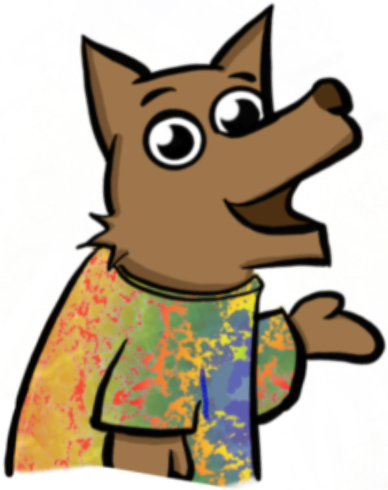
This article is a chronology of our common history with BaoBan. From the story of his ancestors, to how he was brought to life and given a name, and finally his meaning to us, to our roots as a scientific collaboration, and to our environment.
The Tohono O’odham Nation
DESI resides in the Mayall telescope at Kitt Peak National Observatory (KPNO), which sits atop I’oligam Du’ag (audio below) in the homeland of the Tohono O’odham (audio below) Nation (TON). Since time immemorial the Tohono O’odham (TO), meaning “desert people”, have lived in the Sonoran desert and preserved their rich culture. The nation is governed by the TON Tribal Government, organized into 11 districts. You can learn more about the history and culture of the TON here. We are deeply grateful for their permission to undertake observations of the night sky within the TON homeland at KPNO, and we cannot emphasize enough that the success of our scientific mission would not be possible without the TON’s generosity.
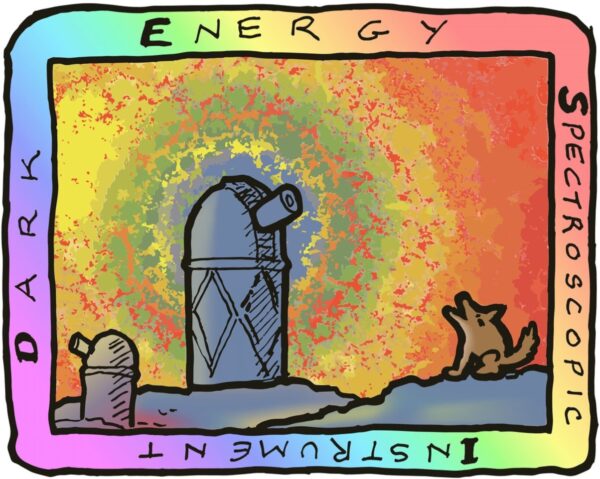
The DESI logo
It is this relation to the TON that must have inspired Berkeley Lab engineer (and artist!) Robin Lafever when he created the DESI logo in 2013, and in particular the detail in the lower right corner: the profile of a howling coyote. In fact, the coyote plays an important role in the TO mythology. Robin had seven different names for the coyote in mind, his favorite being “Bao Wao Wao”. “Bao” is reminiscent of baryon acoustic oscillations (BAO), the primary cosmological observable DESI is measuring to infer the expansion history of the universe, and “Wao” represents the coyote’s howl.
A new coyote is born
The DESI logo inspired Claire Lamman, PhD student at Harvard University and member of the DESI EPO committee, to transform Robin’s profile-view creation into a fully-fledged comic figure. As you can see in her comic strips, at first the coyote seems nice and harmless, but the sheer power of the Dark Energy Spectroscopic Instrument occasionally evokes his dark side. All Claire’s comic strips can be found here.
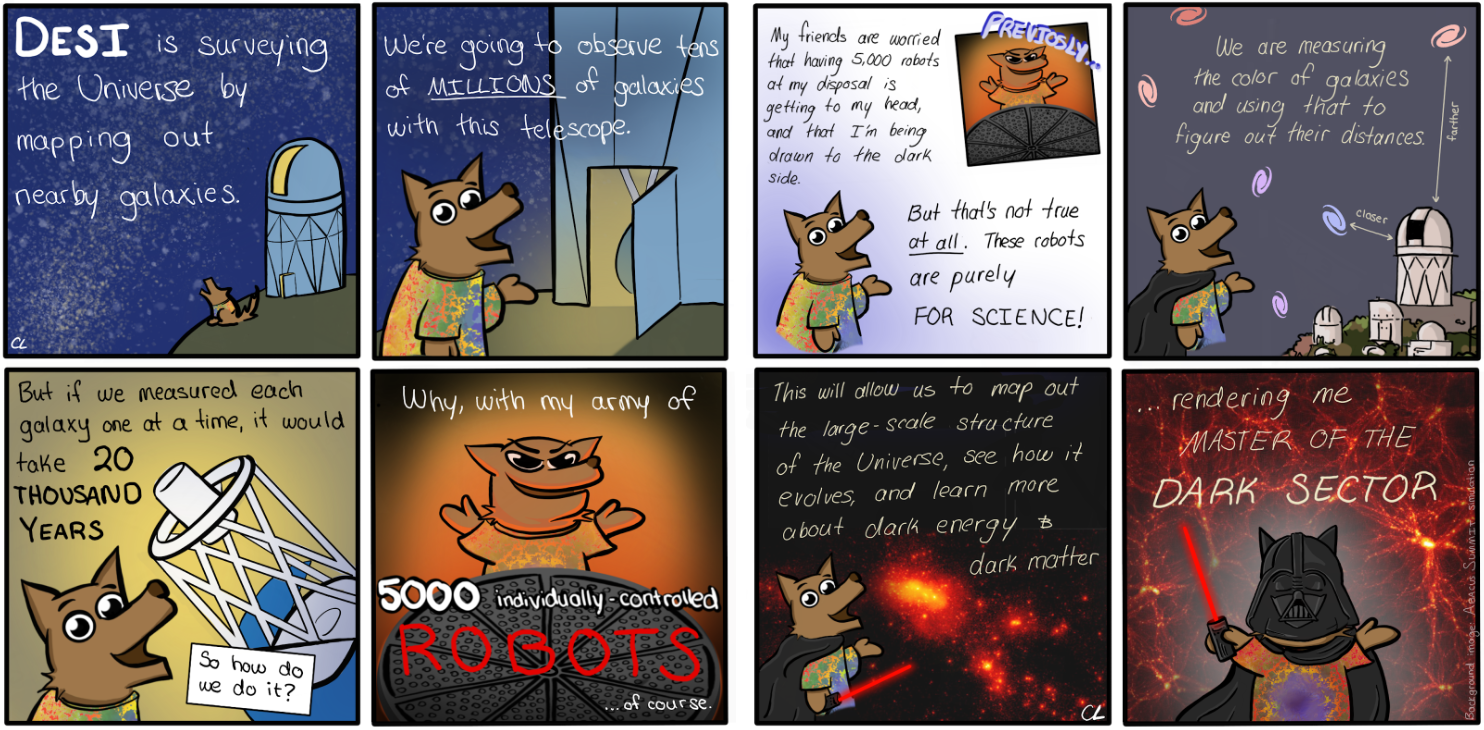
Amazed by his strong character, the EPO committee considered how to introduce Claire’s extraordinary art to the public. There was only one thing missing for Claire’s comic figure to become even more successful than Looney Tunes legend Wile E. Coyote: a proper name!
Setting up a poll
Several candidates emerged from our initial brainstorming, playing either on the location of the telescope (Coyote-Kitt, Maya), on the pursued science (Cosmo-Coyote, Bao), or simply on the survey name itself (Desiree). This was so much fun that we decided to poll the entire collaboration for suggestions. Other names received were Can-do Canis, Desita, and the name of the original coyote in Robin’s DESI logo: Bao Wao Wao. Around 60 collaboration members voted in just one day, and the majority decided to conduct a naming contest within the Tohono O’odham school district (see the compilation of Slack messages below).
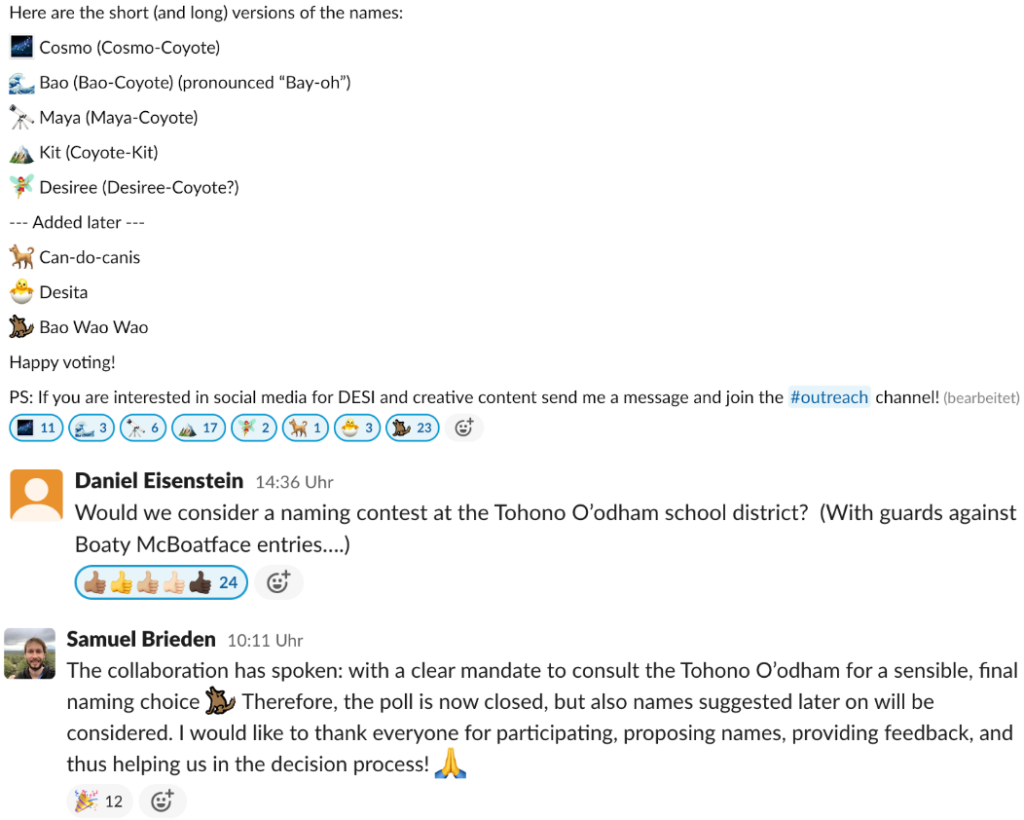
Back to the roots
We first consulted Jacelle Erin Ramon-Sauberan, PhD Candidate at the University of Arizona, faculty at Tohono O’odham Community College, and information specialist for AURA/NOIRLab, and worked closely with KPNO. Jacelle put us in contact with the TON Youth Council (TONYC). The TONYC consists of four representatives from each of the 11 districts, and their mission is to enhance the cultural awareness and self-esteem of TON youth within modern times by organizing social events. The Council holds monthly meetings, which are open to the public. Francine Senechal, the TONYC Manager, kindly invited us to present the coyote naming contest at a Council meeting.
At the same time we decided to reach out to the TON, two collaboration members independently raised the idea that the name include “Ban”, the word for “coyote” in the TO language. It was suggested that we connect “Ban” with the TO word “Ba:”, meaning “Where”, such that the combination “Ba:Ban” is extendable to “Where is coyote looking?” This would allude to the mysteries of dark energy DESI is trying to unravel, and sparked the obvious idea of “BaoBan”, combining “Ba:Ban” with the previous suggestions that include “Bao”.
The day of the TONYC meeting arrived, and fortunately it was held virtually so I could attend from Barcelona. After introducing DESI and the science we pursue with it, I talked about our plan to find a name for the DESI coyote. I provided a list of all the suggestions we had collected so far, as well as their variants, meanings, pronunciations, etc., and asked them to vote for the name they found most suitable. The TONYC members were interested and very keen to help. They agreed to bring the list of names into the local youth communities of the district each of them represents, engage their members to discuss the different options, and choose their favorite name.
The final decision
After thoroughly considering all names, discussing them within each district, and exchanging their ideas at a meeting, the TONYC voted, and Francine communicated the official result:
- BaoBan
- Cosmo Coyote
What a great choice! Within the EPO committee we immediately fell in love with the name BaoBan, as it nicely combined all the different ideas the collaboration had in mind throughout the process. “Ban” as the TO word for coyote, reminding us of the roots of where the DESI telescope is built, and “Bao” as both the sound the coyote makes, and a clear reference to DESI’s primary science goal: measuring BAO from galaxy maps. These ideas culminated in another new comic strip by Claire (below), which celebrates that together with the TONYC we found such a beautiful name for our DESI ambassador! And there is even more to the story…
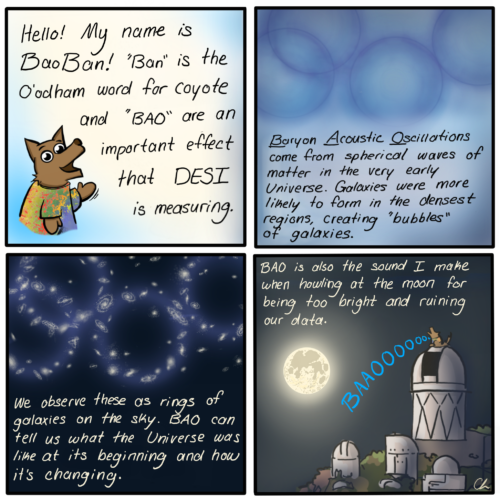
An alternative meaning
Not only did the TONYC vote for the name, they also put me in contact with TO language experts Leslie Luna and Ronald Geronimo from the TO Community College, with whom I discussed the prospect of connecting “BaoBan” to the meaning behind the similar suggestion “Ba: Ban”, where “Ba:” = “Where?” as mentioned before. As it turns out, the TO expression “Ba: ‘o …” actually means “Where is …”, but this does not imply that “Ba: ‘o Ban” would mean “Where is coyote”, because “‘o” is an auxiliary verb that must be accompanied by a full verb. However, we can extend the expression to “Ba: ‘o ñia g Ban” (audio below), which literally means “Where is coyote looking?” and argue that “BaoBan” (audio below) is just the short form of that longer name. In this way, the name BaoBan also serves as a symbol that we and the TON may work together to explore new discoveries in our beautiful sky.
Final remarks
Throughout this process it has been amazing to see how an enjoyable drawing and a simple idea (finding a name for that drawing) can lead to something big, both engaging the collaboration and establishing a new link between DESI scientists and the TO community.
BaoBan symbolizes how the enormous scientific effort by ~70 member institutions with over 700 active collaboration members from all over the world is deeply connected with the TO, who share part of their homeland to discover the mysteries of our universe. BaoBan reminds us that the night sky is the same for everyone, independent of national or cultural identity. Furthermore, BaoBan reminds us to always respect our roots and our environment, and to never forget that the deeper our maps of the cosmos become, the deeper the relationships we will foster among different cultures and people.
It is no coincidence that Robin Lafever began this processes at the very moment his pencil touched paper to create the DESI logo. Robin was known as a man with a wonderfully warm and engaging personality, who delighted everyone around him with his creativity. Almost two years after his passing he would surely be flattered that people enjoy his creation enough that they continue to develop it, from Bao Wao Wao to BaoBan.
Acknowledgements
I would like to express deep thanks to all the wonderful DESI collaborators involved in this journey, those who participated in the poll and brought in their naming suggestions, and especially Claire Lamman, Angela Berti, Biprateep Dey, Parker Fagrelius, and everyone from the DESI EPO committee. Special thanks also to Daniel Eisenstein, Dustin Lang, Eric Linder, David Sprayberry, Lori Allen, Arjun Dey, Nathalie Palanque-Delabroullie, Kyle Dawson, and Michael Levi. Finally, I am indebted to Jacelle Erin Ramon-Sauberan, Francine Senechal, Leslie Luna, and Ronald Geronimo for all their effort and kindness giving me insight into their fascinating culture.